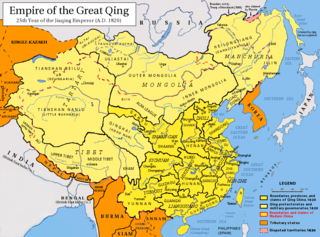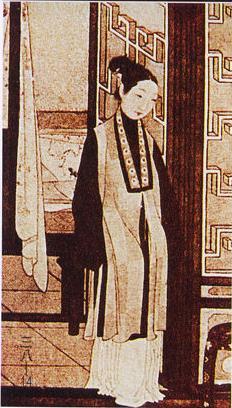| |||||
| Decades: | |||||
|---|---|---|---|---|---|
| See also: | Other events of 1689 History of China • Timeline • Years | ||||
Events from the year 1689 in China .
| |||||
| Decades: | |||||
|---|---|---|---|---|---|
| See also: | Other events of 1689 History of China • Timeline • Years | ||||
Events from the year 1689 in China .

The Qing dynasty, officially the Great Qing, was a Manchu-led imperial dynasty of China and the last imperial dynasty in Chinese history. The dynasty was officially proclaimed in 1636 in Shenyang, and seized control of Beijing in 1644, which is considered the start of the dynasty's rule. The dynasty lasted until 1912, when it was overthrown in the Xinhai Revolution. In Chinese historiography, the Qing dynasty was preceded by the Ming dynasty and succeeded by the Republic of China. The multi-ethnic Qing dynasty assembled the territorial base for modern China. It was the largest imperial dynasty in the history of China and in 1790 the fourth-largest empire in world history in terms of territorial size. With over 426 million citizens in 1907, it was the most populous country in the world at the time.

The Treaty of Nerchinsk of 1689 was the first treaty between the Tsardom of Russia and the Qing dynasty of China. The Russians gave up the area north of the Amur River as far as the Stanovoy Range and kept the area between the Argun River and Lake Baikal. This border along the Argun River and Stanovoy Range lasted until the Amur Annexation via the Treaty of Aigun in 1858 and the Convention of Peking in 1860. It opened markets for Russian goods in China, and gave Russians access to Chinese supplies and luxuries.
The recorded military history of China extends from about 2200 BC to the present day. Chinese pioneered the use of crossbows, advanced metallurgical standardization for arms and armor, early gunpowder weapons, and other advanced weapons, but also adopted nomadic cavalry and Western military technology. China's armies also benefited from an advanced logistics system as well as a rich strategic tradition, beginning with Sun Tzu's The Art of War, that deeply influenced military thought.

Zhang Dai (1597–1684) was a Chinese essayist and historian. He was a gentleman essayist who was a biographer of his own privileged aristocratic family, a historian of the Ming Dynasty, and a biographer of notable virtuous figures. He wrote his own obituary which included the lines : He loved pretty maidservants, he loved handsome serving boys. .. he loved perfect food. .. he loved paintings of flowers and birds.

Zhang Xianzhong, courtesy name Bingwu (秉吾), art name Jingxuan (敬軒), was a Chinese peasant leader who led a peasant rebellion from Yan'an wei, Shaanxi during the Ming-Qing transition. He conquered Sichuan in 1644, and named himself king and later emperor of the Xi dynasty. His rule in Sichuan was brief, and he was killed by the invading Qing army. He is commonly associated with the massacres in Sichuan that depopulated the region. However, the extent of his killings is disputed.
The literary inquisition, also known as speech crime (以言入罪), refers to official persecution of intellectuals for their writings in China. The Hanyu Da Cidian defines it as "the ruler deliberately extracts words or phrases from intellectual's writings and arbitrarily accuse him in order to persecute him" ("旧时谓统治者为迫害知识分子,故意从其著作中摘取字句,罗织成罪"). The inquisition took place under each of the dynasties ruling China, although the Ming dynasty was particularly notorious for the practice.

The Sino-Russian border conflicts (1652–1689) were a series of intermittent skirmishes between the Qing dynasty of China, with assistance from the Joseon dynasty of Korea, and the Tsardom of Russia by the Cossacks in which the latter tried and failed to gain the land north of the Amur River with disputes over the Amur region. The hostilities culminated in the Qing siege of the Cossack fort of Albazin in 1686 and resulted in the Treaty of Nerchinsk in 1689 which gave the land to China.
The Southern Ming, also known in historiography as the Later Ming, officially the Great Ming, was an imperial dynasty of China and a series of rump states of the Ming dynasty that came into existence following the Jiashen Incident of 1644. Peasant rebels led by Li Zicheng who founded the short-lived Shun dynasty captured Beijing and the Chongzhen Emperor committed suicide. The Ming general Wu Sangui then opened the gates of the Shanhai Pass in the eastern section of the Great Wall to the Qing banners, in hope of using them to annihilate the Shun forces. Ming loyalists fled to Nanjing, where they enthroned Zhu Yousong as the Hongguang Emperor, marking the start of the Southern Ming. The Nanjing regime lasted until 1645, when Qing forces captured Nanjing. Zhu fled before the city fell, but was captured and executed shortly thereafter. Later figures continued to hold court in various southern Chinese cities, although the Qing considered them to be pretenders.

The transition from Ming to Qing or the Manchu conquest of China from 1618 to 1683 saw the transition between two major dynasties in Chinese history. It was a decades-long conflict between the emerging Qing dynasty, the incumbent Ming dynasty, and several smaller factions. It ended with the consolidation of Qing rule, and the fall of the Ming and several other factions.
Dragon robes, also known as gunlongpao or longpao for short, is a form of everyday clothing which had a Chinese dragon, called long (龍), as the main decoration; it was worn by the emperors of China. Dragon robes were also adopted by the rulers of neighbouring countries, such as Korea, Vietnam, and the Ryukyu Kingdom.

The Qing dynasty was an imperial Chinese dynasty ruled by the Aisin Gioro clan of Manchu ethnicity. Officially known as the Great Qing, the dynastic empire was also widely known in English as China and the Chinese Empire both during its existence, especially internationally, and after the fall of the dynasty.

The Qing dynasty in Inner Asia was the expansion of the Qing dynasty's realm in Inner Asia in the 17th and the 18th century AD, including both Inner Mongolia and Outer Mongolia, both Manchuria and Outer Manchuria, Tibet, Qinghai and Xinjiang.
Events from the year 1667 in China.
Events from the year 1668 in China.
Events from the year 1672 in China.
Events from the year 1677 in China.
Events from the year 1685 in China.

Bijia is a long, sleeveless jacket of Mongol origins which has opened side slits. The bijia started to be worn in the Yuan dynasty when it was designed by Empress Chabi. The bijia eventually became one of the most typical form of women's clothing item in the Ming dynasty and in the Qing dynasty. It is also a type of hanfu which has been revived in present days.
Dream Memories of Tao’an is a collection of autobiographical essays written by Ming dynasty scholar and prolific writer Zhang Dai. It is considered one of Zhang Dai's most famous works and a summit of xiaopin style essays in the late Ming dynasty.